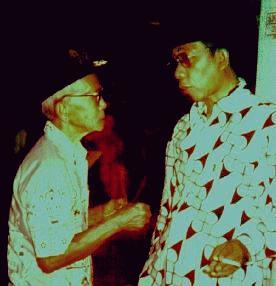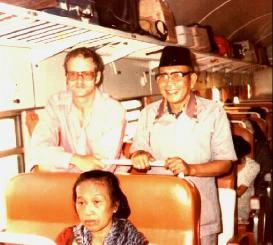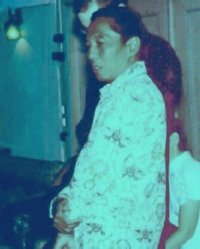V
Kebatinan and
Sumarah
Traditional Kebatinan
Lahir
and batin are the two faces of existence.
Lahir is the external, the form of being --
what we see, touch, hear, taste and feel. You can
measure, manipulate and test it with instruments.
Western science studies lahir. Batin is the internal, the sense of being.
Batin is what we experience itself -- the
seeing, touching, hearing, tasting and feeling.
Batin is what we are. Open psychology
studies batin.
Kebatinan
is a set of traditional practices that teach the
reception and appreciation of reality (the word
comes from batin -- kebatinan). The
various disciplines are designed to help you know
and use your senses -- your interface with reality
-- more accurately, and see reality more clearly;
the central concern is to unite what you
experience and what is actually here, that is, to
attain an ongoing union of batin and
lahir. When lahir and batin are
one -- not separated by hope, dread, denial,
evasion, that is, the various forms of pamrih
(distortion) -- acceptance of reality has been
attained and service can be rendered. This is the
basis of both traditional and modern kebatinan.
Kebatinan's
traditional form is a series of tapa
(austerities, fasts and disciplines), generally
practiced in secret, with the master/pupil (guru/murid)
relationship being held sacred. Kebatinan was
closely connected with power and rule, though the
link was properly through service, not ambition. A
leader with high consciousness can better serve
his people.
Traditionally, a leader is the seat of his
people's consciousness, the source of their vision
and attitudes, and the expression of their
sense of community. A responsible leader embodies
nya gusti, nya kawula, "Where there is a
lord, there is a servant."
The Indic
dewaraja (divine king) tradition (note the
linga element in the titles below) is still
reflected in the titles of Java's four Muslim
kings, all descended from the Mataram Kingdom that
flourished in the Seventeenth Century. The royal
title in the eldest house is Pakubuwana
(Solo), "Nail of the World", the second is
Hamengkubuwana (Yogya), "Holding the World in
his Lap", the third is Mankunegara (Solo),
"Holding the Country in his Lap", while the fourth
is called Pakualam (Yogya), "Nail of
Nature".
The court
was the center of kebatinan practice and the
kingdom's most powerful adepts gathered there to
teach and lend their strength to the king. The
royal family was strictly disciplined in these
practices; one Pakubuwono Prince practices healing
in his palace, doing an open reception (rasa
murni) diagnosis, after which he advises the
use of herbal medicine or massage or whatever. He
told me that his uncle fasted without eating,
sleeping or talking (ngebleng), while
wandering about Central Java for forty days in the
1920s, resting by leaning against trees. Such
rigorous fasting has become rarer but the
tradition still exists (a forty-day fast was
reported in the news in 1979).
The
traditional fast and abstinence periods are one,
three, seven and forty days, and reasons for
fasting include:
1.
Seeking benefit (wealth, position, success),
often for someone else
2. Seeking inner peace and
harmony in the world
3. Seeking to receive the
Will of God
4. Seeking invulnerability
1 (kekabalan)
5. Seeking to increase
sensitivity and communicate with spirits
Fasts and abstinences are common knowledge in
Central Java; in traditional court society, two
days were reserved for fasting (no eating or
drinking) each week. This and many other forms of
fasting are commonplace, and are connected with
alertness and responsibility. Many of the less
rigorous forms are still done frequently at all
levels of society. For example, our maid's
sixteen-year-old brother completed a mutih
fast (eating only unsalted white rice) for seven
days with five of his classmates in his hamlet. A
woman told me that she did ngebleng (no
eating, drinking or sleeping) when she was a
teenager. Her father used to go to the door of the
secluded room where she did the fast each morning
and knock, waiting for her to cough to tell him
she was all right.
One of our
neighbors did a lot of fasting and recommended
mutih (rice-fast) for learning
self-discipline. A friend sometimes did
twenty-four hour pasa (no eating or
drinking) when her son had exams. The many forms
of fasts, abstinences and austerities include the
following:
Tapa
melek - remaining
awake
pasa - not eating or
drinking
mutih - eating only
unsalted rice, usually for the longer
periods
ngrowat - the same as
mutih except with cassava
pati geni - eating
only raw fruits and vegetables
mbisu - not speaking
ngebleng - not eating,
sleeping or talking
kungkum - meditation
while sitting in water (especially a river
or spring) usually after midnight
Some tapa are deemed particularly effective
for specific purposes. For example, mutih
and ngrowat and good for learning
self-discipline; pati gene for increasing
sensitivity and communicating with spirits;
kungkum for seeking invulnerability; and
ngebleng for receiving Divine Will. However,
all the tapa can be used in the more
fundamental task of "conforming to the true nature
of the desires".
Modern
Kebatinan
Modern kebatinan groups continue this tradition,
but with some significant changes in organization
and emphasis. Traditional kebatinan, with its
secrecy and its tapa, is still practiced,
but the modern groups are open societies. Some
groups keep their practice "secret", but all
members learn it and membership is open to the
public. Knowledge about these practices can also
be obtained from people who have gone from group
to group.
A second
difference is size: traditional kebatinan is
limited to a teacher and a few pupils; some of the
modern kebatinan groups, such as Pangestu, Sapta
Darma and Subud, have in excess of one hundred
thousand members, and Subud also has international
chapters. There are some 350 nationally registered
groups; according to PAKEM (the government
supervisory agency), there are fifteen groups
active in Solo. The group we will be using to
illustrate Javanese mysticism and open
psychology is Sumarah, which has about ten
thousand members nationally, coming from all
classes and virtually all walks of life.
Another
difference from tradition is the a governmentally
supervised end to the search for power or
influence in modern groups. As Suhardo, one of Sumarah's founding members affirmed, "This
is a study to help bring peace to the world, not
for personal benefit."
one of Sumarah's founding members affirmed, "This
is a study to help bring peace to the world, not
for personal benefit."
The common
core to both traditional and modern kebatinan is:
belief in the Divine character of being, and in
the operation of Natural Law; concern for
developing accurate reception of reality; and
giving service to God and society. Powers (ilmu),
such as invulnerability, are part of traditional
kebatinan, but the modern groups do not deem them
important. A martial aspect was initially very
prominent in the modern groups (practicing a
Javanese form of karate), but has died out since
Indonesian independence was attained.
Like
Sumarah, many of the modern groups teach healing
and various forms of "extra-normal communication"
used in teaching, but different groups emphasize
various distinct specialties. Considering the Solo
groups, for example: Mahayana and Panunggalan
teach astral travel2
(kasukman); Subud, Sumarah, PKMG, Sapta
Darma and Perjalanan instruct in healing; and
Perwathin (the local version of Theosophy) and
Papandaya study philosophy and doctrine. All of
the groups do some form of meditation.
Modern
groups have integrated many Western terms and
theories into their practices, and might be termed
an attempt to assimilate some of the information
that has flooded Java this century. There is a
conscious concern with protecting the Javanese
tradition through analysis, articulation and
dissemination: "We Javanese are a proud people. We
are proud of being what we are and loving as we
do."
Sumarah
Surakarta (Solo) and Yogyakarta (Yogya) are both
traditional court cities and rival centers of
Javanese culture (each with two of the four Royal
families in residence). Sumarah's founder, Sukino,
came from a family in the lower Yogya aristocracy,
and practiced kebatinan like virtually everyone
else in Central Java. In 1935 he received a series
of revelations (wahyu) that led him to
start Sumarah, first as a small, informal group in
Yogya and then in a couple of years in Solo as
well. The principles of the practice were set down
in the Sesanggeman ("Aims of Sumarah")
written in 1940 and signed by the three founding
leaders.
Sesanggeman --
The Aims of Sumarah
(An association dedicated to
material and spiritual peace through total
surrender to God in meditation)
1. The
members of "Paguyuban Sumarah" are certain of the
existence of God, Creator of the Cosmos, and
acknowledge the Prophets and the Holy Books.
2. They work to be constantly
aware of God, by avoiding egoism and arrogance,
and by believing in the ultimate truth, through
self-surrender to God.
3. They strive toward bodily
health, peaceful hearts and clean spirits, and to
refine their character both in words and deeds.
4. They work to strengthen the
brotherhood of man through love and compassion.
5. The aim to work toward
universal and spiritual harmony, by accepting the
responsibilities of daily life, by responding to
the needs of society as a whole, and by fulfilling
their duty as citizens.
6. They vow to do right, submit
to the laws of the country, and respect other
human beings; not to defame the beliefs of others,
but rather to act on the basis of love, so that
all spiritual and religious groups develop toward
the same aim.
7. They vow to avoid evil
actions, hurting, hating, sinning, etc.; all
speech and actions are to be unpretentious and
true, and to be performed perfectly and
accurately, without haste or strain.
8. They vow to develop
diligently in both spiritual and worldly spheres.
9. They vow not to be
fanatical, but to rely of truth, which in the end
benefits all people.
Yogyakarta and Surakarta, 12
Mulud Dhal 1871 (April 22, 1940)
Sukino,
Suhardo, Sutadi
Many early Sumarah members had long been involved
in kebatinan practice, including Sukino's first
adherent, Suhardo, another member of the lower
Yogya aristocracy, who will be discussed at some
length below. The third of the pinisepuh
(Sumarah's three original leaders or elders) was
Sutadi, from the Solo aristocracy. Each of these
leaders took on an organizational role: Sukino was
the spiritual head; Suhardo became the educational
head, carrying the practice to many cities in East
and Central Java by going there to live and work,
and starting groups at the same time; and Sutadi
was the organizational head, responsible for
coordination.
Sumarah's
first phase (1935-1950) centered on the
pinisepuh, with the practice including
meditation with spontaneous movement, and training
in pencat silat, the Javanese martial art
(similar to kung fu) and invulnerability (kekabalan).
Java was struggling for independence, and the
practice emphasized tekad ("resolve"), as
well as the quieting of thought.
During
Sumarah's second phase (1950-1966), Surono took
over the leadership and formalized the
organization. Sumarah doctrine was published and
new terms entered the practice from Western
medicine and science, and a great deal of stress
was placed on ranks or levels of consciousness. In
the first phase, young members (keanoman)
focused on the physical and martial side of the
practice, while older members (kesepuhan)
stressed the development of consciousness through
meditation. During the second phase, Sumarah was
divided into seven ranks that met separately, and
practice emphasis shifted from developing
"resolve" (tekad) to producing "faith" (iman).
Movement was de-emphasized in the meditation and
meetings became periods of quiet, calm meditation
and discussion. Surono was also a focal point on
articulating Sumarah with the "Spirit Realm",
which may have been what drew me to the group in
that my experience was openly defined with
beings such as Hecate and Tara when I reached
Java.
The third
phase (1966-present) has been lead by Arimurthy,
and group organization has gone from Surono's
tight centralization to regional semi-autonomy
witnessed at present. Group doctrine is also less
structured, with individual leaders granted more
freedom to develop a form of instruction that fits
their local circumstances. There are yearly
congresses in Yogya where the year's events and
Sumarah business are discussed; however, the
organization headquarters have been moved to
Jakarta. Initiation and rank are not emphasized
now, with the seven strata having been reduced to
two. Nowadays there are the regular meetings that
are open to the public, and leader-training
meetings that are by invitation. Practice terms
and theory have become more modern and variegated,
reflecting the leaders' differing backgrounds and
ages, and the focus of the practice has shifted
from "faith" (iman) to "surrender" (sumarah).
1.
Invulnerability refers to the kinds of phenomena
often reported in connection with the martial arts
(kung fu, karate, etc.) in which the practitioner
develops exceptional powers of resistance and
tolerance for pain. One of the guides, Sri
Sampoerna, used to do this practice before coming to Sumarah, and describes impressing his
students by viciously slashing his arm with a
knife without making a wound: curious behavior in
any case but he surely got the attention of a
stunned class.
coming to Sumarah, and describes impressing his
students by viciously slashing his arm with a
knife without making a wound: curious behavior in
any case but he surely got the attention of a
stunned class.
2. I have no personal basis to
judge astral travel on except its status as a
common practice in Java and the testimony of a
close friend (Sularko, my dear friend, Javanese
teacher and chess partner, who was also the PAKEM [Kebatinan Activities
Supervision] Supervisor at the Justice Department
in Solo) whom I would term a reliable informant.
Astral travel has such an escapist aura in Western
use that I was not overly interested in pursuing
it, but I did ask my down-to-earth, and by no
means credulous, friend about his experiences. He
casually told me that, in his capacity as PAKEM
Supervisor, he had been accompanied by an
adept to where he had been shown The Book of
Life; I was obliged to give him stunned
credence. However, regarding the "extra-normal
communication" techniques, since I became a
Sumarah guide and practiced them, I can testify
that they both exist and are quite easily done
after enough sensitivity has been attained.
was also the PAKEM [Kebatinan Activities
Supervision] Supervisor at the Justice Department
in Solo) whom I would term a reliable informant.
Astral travel has such an escapist aura in Western
use that I was not overly interested in pursuing
it, but I did ask my down-to-earth, and by no
means credulous, friend about his experiences. He
casually told me that, in his capacity as PAKEM
Supervisor, he had been accompanied by an
adept to where he had been shown The Book of
Life; I was obliged to give him stunned
credence. However, regarding the "extra-normal
communication" techniques, since I became a
Sumarah guide and practiced them, I can testify
that they both exist and are quite easily done
after enough sensitivity has been attained.
 one of Sumarah's founding members affirmed, "This
is a study to help bring peace to the world, not
for personal benefit."
one of Sumarah's founding members affirmed, "This
is a study to help bring peace to the world, not
for personal benefit."  coming to Sumarah, and describes impressing his
students by viciously slashing his arm with a
knife without making a wound: curious behavior in
any case but he surely got the attention of a
stunned class.
coming to Sumarah, and describes impressing his
students by viciously slashing his arm with a
knife without making a wound: curious behavior in
any case but he surely got the attention of a
stunned class.  was also the PAKEM [Kebatinan Activities
Supervision] Supervisor at the Justice Department
in Solo) whom I would term a reliable informant.
Astral travel has such an escapist aura in Western
use that I was not overly interested in pursuing
it, but I did ask my down-to-earth, and by no
means credulous, friend about his experiences. He
casually told me that, in his capacity as PAKEM
Supervisor, he had been accompanied by an
adept to where he had been shown The Book of
Life; I was obliged to give him stunned
credence. However, regarding the "extra-normal
communication" techniques, since I became a
Sumarah guide and practiced them, I can testify
that they both exist and are quite easily done
after enough sensitivity has been attained.
was also the PAKEM [Kebatinan Activities
Supervision] Supervisor at the Justice Department
in Solo) whom I would term a reliable informant.
Astral travel has such an escapist aura in Western
use that I was not overly interested in pursuing
it, but I did ask my down-to-earth, and by no
means credulous, friend about his experiences. He
casually told me that, in his capacity as PAKEM
Supervisor, he had been accompanied by an
adept to where he had been shown The Book of
Life; I was obliged to give him stunned
credence. However, regarding the "extra-normal
communication" techniques, since I became a
Sumarah guide and practiced them, I can testify
that they both exist and are quite easily done
after enough sensitivity has been attained.